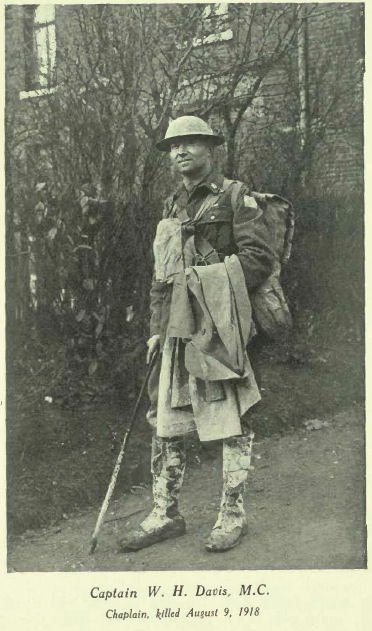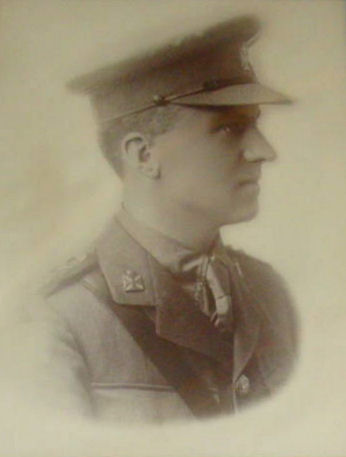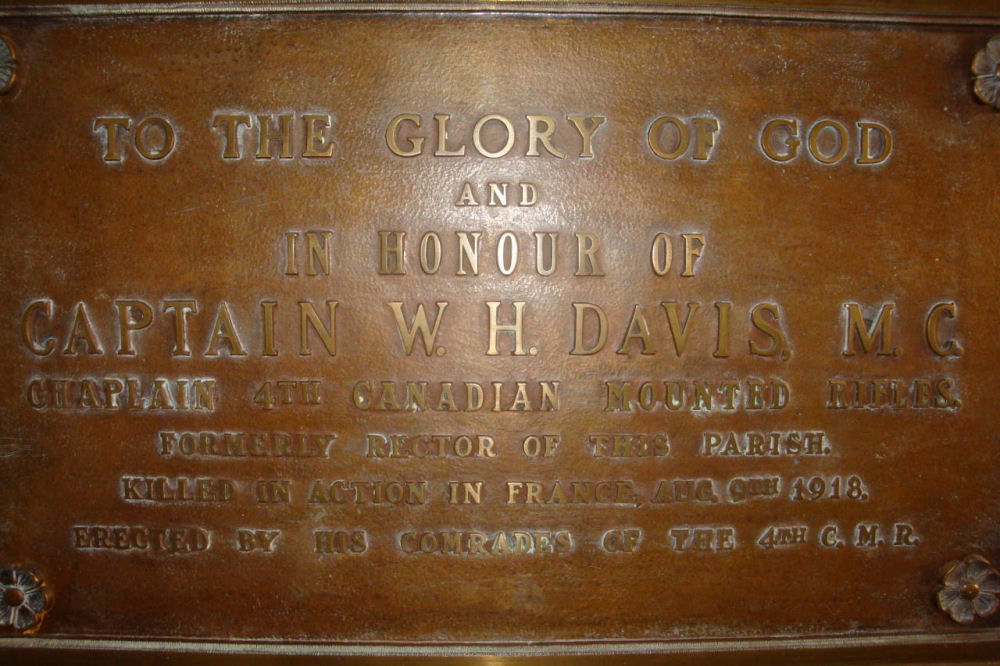
Hon. Captain Rev. William Henry Davis, MC was one of that small band of brave and selfless men of God who served and often gave their lives as Chaplain to the men of the 4th CMR.
An Irishman by birth, born in Tullamore, King's County (now County Offaly), Ireland, on January 21st, 1883, William was a "Clerk in Holy Orders" with the Church of England at the time of his attestation into the 138th (Edmonton) Battalion, in Edmonton, in March 1916.
One of 14 serving clergymen in the 4th CMR, William joined the regiment in the field in February 1917, where he quickly won the admiration of the men and was referred to in glowing terms whenever talked about.
Here the S. G. Bennett 4th CMR History of 1926 says of him at Petit Vimy in April 1917:
"The first glimpse they had of their beloved Padre in action was seeing him in the twilight on the crest of the Ridge, his steel helmet hung over his arm, prayer-book in hand, burying the dead, regardless of shells dropping around him."
And of him in the action around Lens in July 1917:
"... there were eighteen other casualties during this tour. Captain Davis, the Chaplain, was with the men as usual, in the front line, doing everything he could for their comfort. For three days he worked with a party of ten men, giving Christian burial to the dead who had been left unburied in the area; his courage and scorn of danger endeared him to all who knew him."
The Regimental War Diary catches him in his duties on October 7th, 1917, as the regiment is under quarantine during a diphtheria outbreak:
"The quarantine forbidding a Church Parade, 'Capt. W. H. Davis, the padre', visited each company in turn and held service in their billets.
From the Regimental History, at Passchendaele on October 26th, 1917:

"There were many others who did more than their mere duty, but none would begrudge another mention of the Chaplain, Captain W. H. Davis. As at Vimy and every other action, so at Passchendaele this Padre exceeded his duty by exposing himself unnecessarily. He went forward with the men, mustering and organizing a party of stretcher-bearers, gaining the admiration of all the combatants by walking about in the open looking for wounded, apparently oblivious of his danger. It was a miracle that he lived to enter another action. His coolness and unselfish thoughtfulness for the welfare of others gained for him a very warm spot in the hearts of all the men. One officer, who saw the Padre laboriously coming toward him through a downpour of "crumps," asked him what he was doing walking around in the open; his reply had its usual candour: "I was getting anxious about you." During the afternoon of the 26th he so successfully controlled the stretcher-bearers and set such a wonderful example that practically all the wounded were collected."
Captain Davis is also mentioned specifically on that occasion in the "Narrative of Events of the Action of October 26th, 1917", where it says:
"Scattered shelling and harrassing fire persisted throughout the day and night but through the splendid efforts of the Battalion Chaplain, Capt. W. H. Davis, and the Stretcher Bearers, our ground was cleared of the wounded."
In April 1918, most likely for the above action, William was awarded the MC - Military Cross. The citation for this reads:
"For conspicuous gallantry and devotion to duty. While the fighting was still in progress he organised and led stretcher parties into the forward area under heavy shell and machine-gun fire. He searched "No Man's Land" throughout the day in full view of the enemy, and set a splendid example of courage and determination."
And finally, concerning his loss on August 9th, 1918, in the taking of Le Quesnel and Folies:
"Every officer and man mourned for their beloved Padre. He came from Western Canada but he had retained his Irish heart and Celtic charm. If he knew what fear was he never showed it. His remarkable disregard for danger while carrying out what he considered his duty, became a regimental tradition. In the daily life of the Battalion, in billets or in trenches he was always thinking of the men's welfare. On this day as on former occasions he was preparing to carry out his practical mission of mercy and was gathering around him his little band of stretcher-bearers when he and one of his men were hit by a shell. No officer was more loved for his character or more admired for his bravery than Padre Davis."

The actual circumstances of his death were that in having gone to Le Quesnel Hospital to secure a stretcher party, he was returning with that party "when an enemy shell exploded at his feet instantly killing him".
Hon. Capt. the Reverend William Henry Davis, Chaplain, lies at rest in Le Quesnel Communal Cemetery, and is represented on the In Memoriam page by the people of the Parish of St. Peter's Anglican Church, in Edmondton, Alberta, where his picture (above, right) and a plaque (left) dedicated to his life and service hangs.
Capt. Davis' further honour was to be 4cmr.com's 100th man on the In Memoriam page.
Click here to see other MC awards
To the people of St. Peter's Parish, and to The Rev. Stephen Hallford, thank you for remembering.
Top left image credit and service details: 4th CMR Regimental History, S. G. Bennett, 1926.
Lower images of William Davis and his dedication plaque thanks to Rev. Stephen Halford and Lyle Falk.
Additional biography details from Capt. William Davis' attestation papers, Library and Archives Canada.
Biography courtesy of David Kavanagh.